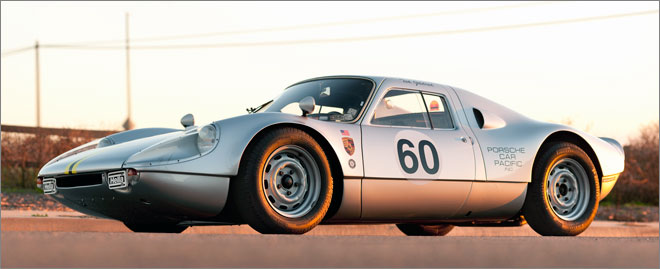This was the last Porsche racer you could collect at the factory and drive home
This Porsche, 904017, was one of 31 examples destined for American shores. Originally finished in silver with a blue velour interior, the 904 was sold to local Porsche dealer and successful racer Don Wester of Monterey, CA. It was fitted with an air deflector and painted with a central stripe in yellow and black, Wester’s racing colors.
After a busy 1964 season, the race-proven 904 was treated to substantial engine and brake upgrades from the factory in preparation for another year of West Coast racing. On August 18, 1965, 904017 achieved what is perhaps its best-remembered win. At the Candlestick Park SCCAA C Production Race, Wester and the Porsche averaged 89.3 mph over the length of the race to beat Phil Hill in a Shelby Cobra, Augie Pabst in a Ferrari GTO and Milt Minter in another 904.
The impressive results of 1965 gave Wester 3rd place overall in the SCCA’s Pacific Coast Division A-Production Class, and the 904 gained some notoriety as well: it was featured prominently in both sports car journals and in Porsche Car Pacific advertising.
When the 904 was replaced by the 906 at the end of the 1965 racing season, it was purchased by Robert W. Hansen of Porsche Car Pacific. After advertising the car in Road & Track, a buyer was found in Walter Bischoff of Stanton, CA, who registered the 904 for road use and kept it until 1969, whereupon it was sold to Bill Randle of Denver, Colorado. Mr. Randle, a Porsche mechanic, drove the 904 on the street and occasionally participated in club racing. After a year, Grady Clay, a customer of his, purchased it for approximately $6,000.
Mr. Clay reports that he finally parted with the Porsche in 1987, selling it to Robert Pass of St. Louis, MO. From there, the 904 was sold through Motor Classic Corporation to Harry Bytzek, a Toronto-based Porsche enthusiast. In the late 1980s, Mr. Bytzek traded the 904 to Dick Barbour, the famed Porsche racer and collector. In December 1989, the current owner purchased the car from Mr. Barbour and the 904 embarked on its second period of active racing.
After participating in the 1991 Monterey Historics, 904017 was sympathetically restored and prepared by Stars & Stripes Motorsports in Carlsbad, California. After being tuned, sorted and prepared by the best four-cam specialists in Southern California, the 904 was ready for an all-out return to racing.
Throughout the 1990s, the 904 became a fixture in the West Coast vintage racing circuit. During its many outings, the Porsche was almost always found at the front of the pack and was kept free from incident. In 2000, the 904 was shipped to Europe, where it successfully participated in the grueling Tour Auto. The Porsche has continued to compete in vintage events at Coronado and Monterey and today, the 904 appears very much the same as when it raced at Laguna Seca in 1964.
Freshened cosmetically and kept in race-ready order, 904017 remains a very correct example that has never suffered from a serious accident, over-restoration, major modification or neglect. Of the 904s with significant racing history, this car is considered to be one of the very best survivors. It is offered with an extensive collection of spare parts that includes everything from minor components to a complete Peter Pohl-built four-cam racing engine. Beyond that, the car is offered with an extraordinary file that includes comprehensive historical documentation divided amongst three separate binders.
1964 Porsche 904 Carrera

